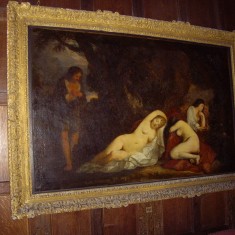Siobhan Barratt
Knole's former Project Conservator, then Knole Conservation Studio Manager, 2015-2017
Interviewed by Christine Nevard and Veronica Walker-Smith
Siobhan explains why conservation is so urgently needed at Knole
My job is looking at the conservation of the collections and the interior of the buildings, so anything that’s within the show rooms, how we conserve those collections, but also how we manage the care for them; so it also takes in things like housekeeping and the cleaning and that side of it. The collection is very old so actually the fact that it has survived for as long as it has is actually quite amazing so I think, you know, there are good things to say. There are very few surviving examples of some of the furniture we have in the state beds so the fact that it’s survived this long is quite amazing. Because it is so old there’s a natural deterioration that will happen with any organic object; everything has got a finite life. However well or carefully you look after it, it is eventually going to sort of drop. But the problem we have at Knole is, the main problem is the show rooms have never had any heating in them, so that leads to very damp conditions and it’s not too bad in the summer but really the winter and the shoulder months – the conditions are really, really damp and we’ve been monitoring those conditions probably for about twenty years now so we can see that the conditions have been incredibly damp. But actually what we are seeing is they are getting worse as well. You know, we’re seeing higher RH [relative humidity] levels in the winter; we are getting more, yes, horrendous rainfall, and – that the historic building structure can’t cope with. So the historic gutters and downpipes are getting overwhelmed and so things aren’t just on a natural deterioration rate. There does seem to be something that is happening or been happening over the last, I would say, ten years, where it is on a downward curve and we are seeing many more examples of mould, and much more pest activity.
Mould on the Knole paintings
S.B: We are getting many more paintings with mouldy surfaces and you can clean off that mould, you’re able to treat it, but if you put the paintings back in the same conditions it will just grow back in a couple of years so and eventually it will start to cause quite a lot of damage.
Does the mould stain paintings?
S.B: Well it does, it comes through from the back so it’s coming through the canvas, and then it comes up through where you get the little cracks in paintings which you get on all old paintings. It comes through those little cracks and that is where you get that sort of white crazing on the surface, but what it will do eventually is it will push that paint off the surface and you will start getting flaky surface and once that happens you are really in trouble because that is then irreversible.
We seem to be having the worst problems in The Leicester Gallery, Spangled Bedroom area. That area seems to be worst and I think having been in there this morning you can feel the damp levels and cold are worst in that bit of the building.
Making the most of the project funding
I looked at the Collection and put together sort of budgets for the conservation work that was needed for the collection, and also ideas of priorities, because although we have got a huge amount of money it’s not enough. It’s never going to be enough. But also we had to consider that when you get money from the Heritage Lottery Fund, they give you a certain amount of time in which to spend it, so we have got until 2018, and actually even if we had more money we wouldn’t be able to do all the work in that time. Conservation is so time-consuming, and there are so few people that are able to the work, you know, actually it doesn’t help having more money; so we know that we’ve got a certain amount of work we can do, but we’ve got another list now, that’s growing, of things that will still need doing when we have finished.
So the good thing is, once we get to 2018, is we will have completed the building repairs, we will have conservation heating in the showrooms so the conditions will be much more favourable, so although the objects will still be in the same condition, hopefully we will have slowed that rate of deterioration right down so at least it gives us more breathing space. But I think it will be a challenge in 2018 to continue it because we are having so much focus on us now, and I think we will over the next few years. Once we get to 2018 there will be something else, another big project somewhere, so we have got to make the most of things at the moment.









No Comments
Add a comment about this page